(Pics) PM Modi Inaugurates Delhi Metro’s Magenta Line (Line-8)
An hour ago, India’s Prime Minister Narendra Modi inaugurated services on the 12.64 km Botanical Garden – Kalkaji Mandir section of Delhi Metro’s new 38.23 km Magenta Line (Line-8). The hour long programme started with an inaugural plaque getting unveiled outside of the Botanical Garden Station, followed by a quick train ride to the Bird Sanctuary Station and culminated with a ceremonial train getting flagged off towards Kalkaji Mandir Station.
Trial runs (testing) on the Magenta Line commenced in June 2016 between the Kalindi Kunj Depot and Okhla Vihar Station, and were extended westward to Kalkaji Mandir shortly after in August 2016. In October 2017, the Delhi Metro Rail Corporation announced the completion of signalling tests and had the Commissioner of Metro Rail Safety (CMRS) conduct a 3-day final inspection between November 13-15.
The brand new Magenta Line of the 162.5 km Phase 3 project is equipped with Nippon Signal’s SPARCS (Simple-structure and high Performance ATC by Radio Communication system) signalling solution which enables Delhi’s new Hyundai Rotem RS-10 trains to be operated on the “driverless” unattended train operation (UTO) mode at a high headway of 90 seconds. Commercial operations will commence at 5 pm today with 10 manned-trains running at a headway of 5 minutes and 14 seconds.
The line was originally planned to be opened by December 2016, but faced delays from a host of reasons ranging from contractor tardiness (including a design screw up), signalling issues in the testing phase and the Gujarat elections. Trains on this line have also been involved in two crashes at the Kalindi Kunj Depot – once in November 2016 and the other just a week ago – both due to operator negligence.
This first section of the line includes 9 stations at Kalkaji Mandir, Okhla NSIC, Sukhdev Vihar, Jamia Milia Islamia, Okhla Vihar, Jasola Vihar Shaheen Bagh, Kalindi Kunj, Okhla Bird Sanctuary and Botanical Garden – all equipped with semi height platform screen doors. While Kalkaji Mandir is underground, all other stations are elevated –

Magenta Line’s map (elevated section) – view Delhi Metro Phase 3 map & info
This section consists of 4 civil packages built by 3 contractors –
• Package CC-23: Kalkaji Mandir Station – Lotus Temple Ramp (Pratibha-FEMC JV)
• Package CC-15: Lotus Temple Ramp – Yamuna Bridge (Afcons Infrastructure)
• Package CC-08: Yamuna Bridge (SP Singla Constructions)
• Package CC-82: Yamuna Bridge – Botanical Garden Station (SP Singla Constructions)
Images from the event –
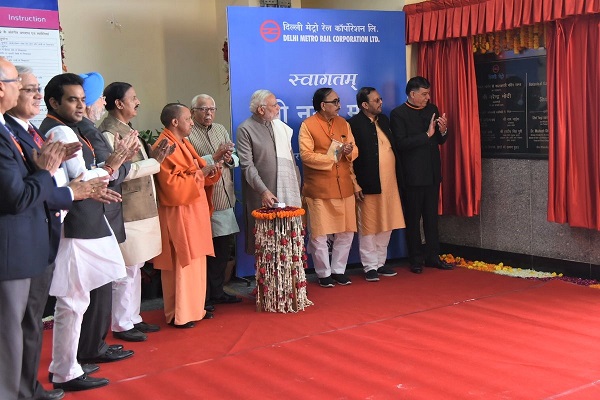
Photo Copyright: PIB
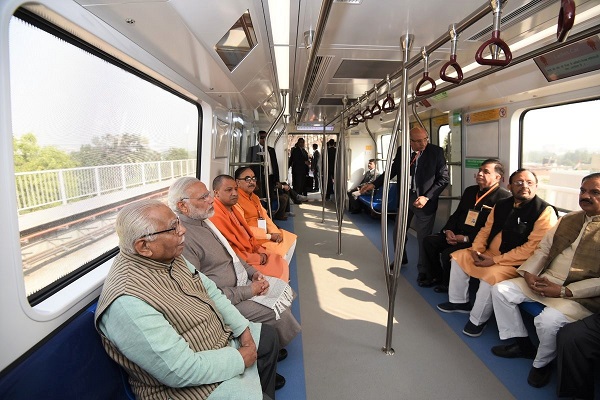
Photo Copyright: PIB
Video – inaugural train getting flagged off –
PM @narendramodi flags off Botanical Garden-Kalkaji Mandir #MagentaLine of #DelhiMetro pic.twitter.com/zWNoMYajnQ
— Doordarshan News (@DDNewsLive) December 25, 2017
Some images shot on Friday during a media tour –
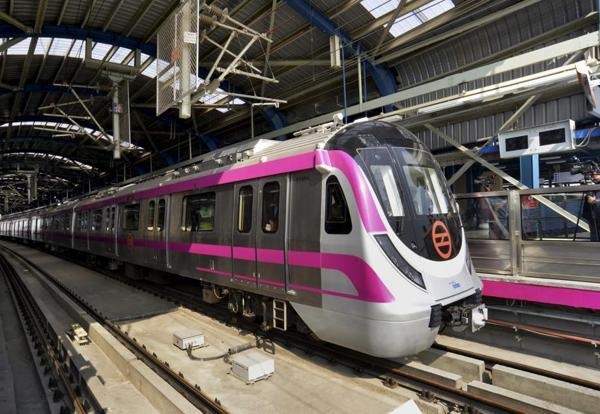
Photo Copyright: Mint/PTI
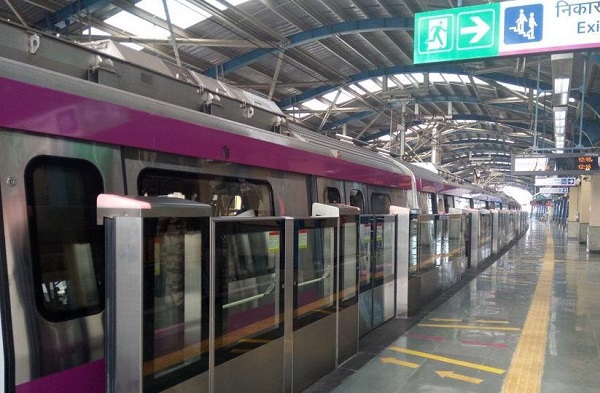
Photo Copyright: Faizan Haider/HT

Photo Copyright: Faizan Haider/HT

Photo Copyright: Faizan Haider/HT
More images from within the trains can be viewed here and images of some stations getting ready for the launch can be viewed here.
With this development, 40.374 km of Phase 3’s 162.5 km routes have become operational and the entire network has become 230.18 km long, surpassing Mexico City’s metro system to claim the 11th spot in the list of largest metro networks.
For more updates, check out the Delhi section of The Metro Rail Guy!
– TMRG
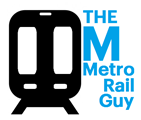



Any specefic reason for Delhi CM not being invited?
Petty politics, nothing else.
yes..
Because at every inauguration he creates a tamasha.
there have been no updates on NOIDA Metro……how is that progressing and when is the planned inaugaration ?
Out traveling right now with little internet access. Will post an update when I’m back to base camp.
When will that be? Hope you’re enjoying some time off.
Not sure – some things are beyond my control. This was supposed to be a quick week long trip, but has turned into something else…
thanks …… when is the other line from NOIDA that will move along VIKAS Marg towards Greater Noida … to commence construction ???
Just to take credit by the politicians the start date have been delayed. Shame in modi and dmrc
Delhi metro phase 4 kb tak aayega
any idea when phase 4 work will start? when other phases -3 routes will start?
Thanks to JICA, Delhi Government, and any other minor stakeholders of this project that I might have left out. Wonder why is Modi so scared by Kejriwal?
When will janakpuri – igi section get commence.
Driverless metro inaugurated CM(seam)lessly.
apparently its not driver-less.
it will be in 2 years time
This stretch is fine but the Noida to Gurgaon line is the big one. That line will significantly boost inter-city mobility in NCR. Travelling from Noida to Gurgaon in a car is an absolute nightmare right now.
Absolutley… i hoped that they should have began operations from botanical garden to atleast hauz khas so that gurgaon and noida would gave come closer. Right now it doesnt seems to fulfil the purpose.
Finally after one whole month of the CMRS go ahead, the “VIPs” spared some time for the people and were available to open the line.
Finally the wait is over. Good to see the prolonged opening of Magenta line.
TMRG, please tell us next time if you are going to be offline for many days. I used to visit everyday just to be disappointed.
Have trials started between igi-d and kalkaji?
When is the remaining section of this line likely to be opened?
I am sorry, but Delhi metro is now the 12th largest, not 11th largest.
You see, today Wuhan metro opened a bunch of lines and is now 240 km.
I am terribly sorry.
George
Delhi Metro is on course to become the 3rd longest metro system in the world by 2022. After the phase 4 is completed, Delhi Metro will have a length of over 470 km, thus easily overtaking current 3rd placed London Metro system which has a length of 402 km.
Easily overtake London by 2022? Let them first build it by then, then we will see. As things stand now, govt has modified the conditions for approval & delhi govt wants low fares. How then will delhi metro be ever self sufficient & get approvals for further extensions? Is delhi state govt capable of financing it entirely?
Delhi metro will be in the top 5 after the current phase 3 (original and late additions) gets completed, which will be in 2019 (could be 2020 also, although lets hope its not).
But phase 4 completion in 2022 is absolutely absurd, Its not even approved yet by the state government. Even if it gets approved next year, the construction wont start before 2019, and it will take atleast 6 years to get it opened for public. So dont expect anything before 2025. Phase 3 has taught us not to expect timely completion from DMRC.
This new metro policy has really delayed the progress of Delhi Metro. Phase 4 was already approved but now they have to prepare new project reports to fulfill the conditions laid down by the new metro policy. I glanced through some of the salient features of the new policy and frankly I am not very convinced.
1. The policy says that cities should have a united transport authority that oversees the operations of all modes of transport, such as metro, buses etc. Sounds great on paper but common sense would indicate that this is next to impossible in Delhi since DTC is owned by Delhi govt while Metro is de facto owned by Central govt. Mix in the private transport companies and you will soon realize that trying to establish a united transport authority will lead to an inevitable political logjam.
2. The policy calls for taking a comprehensive look at first and last mile connectivity. While no one will disagree that lack of adequate first and last mile connectivity is a major problem in India’s metro systems, including Delhi, but should a metro project be scraped if adequate first/last mile connectivity is not presently available. This is a typical ‘which came first – chicken or egg’ problem. The policy might say that a particular city can’t build a metro because the city doesn’t have adequate connectivity but the city could argue that if we build the metro then private companies will step in to provide the connectivity. So how do you decide who is correct? Perhaps both are but this leads to a standstill.
The main problem in the new metro policy is the PPP model and achieving the economic rate of return of 14%. Although these are necessary safeguards for the overall financial health of metro systems which are extremely capital intensive, but initially it will create some challenges to Metro Corporations.
Last mile connectivity, common authority are not big issues, just requires some co-ordination between different departments of government. Although yes, I agree with you, these common things are problematic in Indian environment because of lack of political vision. Delhi is a clear example of this with BJP and AAP govt at loggerheads over every issue,
It is common sense to force agencies to co-ordinate infra development. Urban transport is one of those that essentially requires much higher degree of co-ordination, something that is sorely lacking in India.
City transport agencies MUST co-ordinate BEFORE infra is even planned to be developed. Kudos to central government for the new metro policy. Now all states cannot expect CG’s approval merely by submitting proposals for just a metro system in isolation. They need to submit a whole lot of related transport documents with plans & proposals as well to justify 14% ERR besides quantifying a holistic approach to city transport.
This will put an end to bogus demands for CG’s financial support for building new metro-rails or extensions just as status symbols or as tourist attractions where they do not make sense (like the half a dozen metros that UP wants, most of which are in towns with about 10 lakh population, for example).
Lastly, metro rails are hugely capital intensive & CG cannot & must not keep pumping in tax payers’ money for lines or extensions that do not meet all criteria. Each city’s metro project or extension line must be fully vetted.
Else we will have more goof ups like the Delhi airport high-speed line that had bogus projections, built at huge cost but is now running like an ordinary metro at 80 km with lesser than expected loads (& at lesser fares) after shut-down & costly repairs besides huge arbitration pay-offs.
As Aditya pointed out, requirement of 14% IRR and PPP does not bode well for future metro projects. The govt is treating these projects as commercial projects which should generate substantial profits. But in my opinion, this is a wrong approach. Metro projects should operate on a no-loss basis and should be just cash-flow positive. A 14% return is something that a MNC would require from its projects. Incidentally, the cost of equity for Indian companies is also around 15% (source: EY). There is no rationale why the govt should demand such high returns on a public project as a lot of benefits of metro projects, such as safety, boost to tourism, time savings, less traffic on roads, can’t be adequately captured on a spreadsheet.
Further, PPP metro projects do not have a great track record in India. Fares of Hyderabad Metro, Gurgaon Metro and Delhi Airport Line (now operated by DMRC) are significantly higher than public funded metro projects, despite claims that private companies are more efficient. So, why push for PPP when the govt knows that the fares charged by private companies will be much higher than their public counterparts. There is another problem with PPP i.e. risk sharing. If a metro project becomes unviable or faces problems then the private company can simply choose to exit the project midway. There is nothing stopping them from doing because either the contractual penalties are too low or they can simply exploit our inept judicial system. But the govt can’t ignore an abandoned project (due to moral and political pressure) and it will have to step in and finish the project at the significantly higher cost than initially planned.
Yup.. wkipedia confirms that. Its network is 237 km and Delhi metro is 231 km. With more openings planned in 2018, it will be a tight contest on who reaches the top 10 first.
This TOI article claims that 120 km of new lines will be opened in 2018, as part of phase 3. The system length will increase to 350 km from the present 237 km, thus making Delhi Metro the 5th longest metro system after Shanghai, Beijing, London and New York.
https://timesofindia.indiatimes.com/city/delhi/metro-set-to-add-120km-in-2018-will-become-worlds-4th-largest-network/articleshow/62286997.cms
I read that article too but I think that a slight change will be there, It wont be the 5 th largest, it will be 6 th largest. This is becuase Guangzhou Metro just opened some new corridors and overtook New York Metro and became the 4 th largest metro. So Delhi will be at 6 th place after Shanghai, Beijing, London, Guanzhao and New York. Although we also have to see whether other metro expand their network as well (like London, which is building a new line). That might change the ranking. But yes, Phase 4 will be a game changer for Delhi Metro, although we dont know, when it will start.
As per delhi metro updates noida 62 extension is indefinitely delayed due to land acquisition and money from Noida issues.
Noida City Center to Noida Sector 62 line will open in Dec 2018. They are shifting the overhead power transmission lines which has caused a big delay.
The news is late now.
@Rohan:
The 14% quoted is “economic internal rate of return”. Not merely cash profits as you seem to think. Economic returns include improved safety, tourism development, improved productivity due to savings in travel time, accident reduction, pollution reduction etc etc.
If PPP metro projects do not have a great track record in India, all the more reason why we need policies & procedures to make them successful as govts cannot keep pumping more & more money into metro projects alone. Govts have many other expenses to meet than building metro rails. For example, social sectors like health, education, irrigation etc.
Costs for metro infra are hugely expensive. So fares cannot be subsidized in perpetuity like those of Indian railways. Those using metro are expected to pay higher fares. Even these higher fares are subsidized & are not for generating huge profits but to take care of operation & maintenance. Profits in PPP metro projects are through other forms of revenues like real estate exploitation, advertising rights etc.
The problem of risk sharing with PPP can be addressed with proper clauses in the terms. Delhi airport line PPP terms were not properly laid down. As a result, it allowed the PPP partner to walk out without much liability. However, if proper agreements are drawn protecting both sides, things can work out fine as in airport PPPs.
The ERR is merely an eyewash. When the govt and the private company would discuss the modalities of the excel model that determines the expected future cash flows, the private company would never agree to cash flows arising out of tertiary benefits such as safety, tourism development, pollution reduction etc., because they are of no concern to the private player. They are also extremely difficult to quantify. The private player will gain nothing from these tertiary benefits to the public. The ERR only works if there is a single stakeholder, i.e., the govt. PPP and ERR don’t go together, particularly in a country such as India, because the objectives of both these entities are completely different. Private companies want profit maximization while the govt wants maximization of benefits to public.
Metro projects are a part of basic infrastructure similar to hospitals, schools, highways etc. It is indeed the govt’s responsibility to provide this infrastructure to the public. If they want the private sector to build this infrastructure then they should reduce the taxes. The govt can’t have its cake and eat it too.
I say that PPP metro projects are a failure in India because they have not been able to reduce costs. A PPP project only makes sense if the private player can bring the costs down to such an extent that even after making the profits, the cost of service to the public is lower. If a private company can demonstrate or agree to an agreement that it will substantially reduce the construction and operating costs then by all means give the projects to a private player, but if they can’t then the keep the project in house. Remember privatization is only beneficial if efficiency can be improved and costs can be brought down. Privatization just for the sake of privatization increases the prices to consumers.
Now you can always argue that even if the private player can’t bring the costs down, at least they can raise the capital by themselves thus saving the govt from raising new debt. This is indeed a valid reason for privatization since less govt debt means lower interest expenditure and perhaps lower taxes. But this system only works in the western economies where the banking sector is completely private. In the US or UK, the private company constructing the metro would take loans from a private bank, say Bank of America or Barclays. If the project fails then the loss is borne by the private company and the private bank, the govt hardly loses any money. But in India since 75% of the banking sector is owned by the govt, if the project fails then public banks, such as SBI or PNB, lose money which means that the taxpayers lose money since these banks have to recapitalized. The current bad loan crisis is a perfect example of this unique situation.
If PPP players such as Gurgaon Metro and Hyderabad Metro are making most of the profits from land utilization and advertising then why are the ticket prices higher as compared to public systems. Other revenue, such as adverts, land lease etc., is usually a very small proportion of total income.
Delhi metro is not subsided but it is still cheaper than Gurgaon and Hyderabad metro system. The recent fare hike in Delhi metro was required because as per their loan agreement with Japan, they have to pay around 30,000 crores over the next 4-5 years. So they needed the extra cash immediately. After the loans are paid off, I don’t expect any major price hikes from Delhi metro apart from the ones that are required to cover the increase in their wage costs and general inflation. If Delhi metro starts focusing on automation and self service thus reducing the employee strength, even those hikes may not be required. But the private player will treat the metro project as a cash cow thus milking the public for eternity.
Stringent risk sharing clauses can’t be introduced since no private company would agree to such clauses.
EIRR (not ERR) is not an eyewash. There are methods to quantify it & it is an absolute necessity in DPRs for govts to approach lenders. EIRR may be of lesser interest to private parties but decisions are always taken based on EIRR. As I said, private parties are roped in to bring in the huge capital required & are offered incentives by way of real estate exploitation, advertising rights etc as done with Hyderabad & Mumbai metros. Fares are always subsidized though the O&M costs are very high with metrorails compared to other forms of mass transits such as rapid bus, light rail or trams. O&M costs for Monorails is even higher, hence fares are higher than metrorails.
Also, fares are determined by fare fixation committees, not by the private players independently. Mumbai & Hyderabad metros have taken precautions in their contracts by including clauses, hence are successful. But Delhi failed to do it in their haste to complete the airport line in time for CWG games, but they still couldn’t do it in time & ended up paying a huge price for it. This does not mean that they can never work.
Further, Metrorail is not basic infra everywhere. They are not for smaller cities or for rural India where majority live & majority of govt spends occur. Even if 15 cities have average 10 million population, they account for a mere 150 million whereas the country’s population is 1300 million or about 9 times more. People not living in large cities are paying taxes to improve basic infra that they require in their smaller cities, towns or villages. Not to subsidize metrorail fares in large cities. People living in large cities & using metrorail are necessarily required to meet part of the high costs for metrorail operations. Likewise, metrorails must not burden the ex-chequer or local govts excessively just as it must not burden metrorail users excessively. Both are required to shoulder costs.
Barring Delhi airport line, there is no evidence to suggest that PPP projects are a failure in India. Hyderabad & Mumbai metros are operating just as efficiently & fares are actually lesser than Bangalore or Chennai metro rails, both of which are public projects. There are limits as to how cheap fares can be kept since O&M costs are very high. Gurgaon metro is too small & more like last-mile connectivity & can be compared with monorail. Fares are bound to be higher for such projects with the limited smaller scope.
Delhi metro is the only one that has been tardy with hiking fares in tune with inflation & O&M costs – they have not hiked up fares for eight years. This is probably because of resistance from delhities who are used to excessive subsidies. Political parties like AAP are also towing this line now to reap political benefits. If this trend continues, DMRC will soon become another Indian railways whose services will deteriorate with poor maintenance & service standards.
Lending from private or public banks is irrelevant. Bad loans may have occurred with public banks in India but the correction required is to rectify the system to prevent them from occurring. Not stop them from lending or conducting their business.
Risks with PPPs have to be shared between partners, not shouldered entirely by the PPP partner or the public player. Risk sharing clauses can be introduced as with airport privatization or highways, both of which are successful. There is a learning curve & PPPs are evolving well in metrorails. No reason why they must be written off, especially since capital required is very high.
From some time I observe that TMRG is not giving time to time updates about progress of metro projects and it also not giving replies of people’s questions that’s seems really disappointing n arrogant.
TMRG is disseminating information through this site investing his own time & without any cost to others. He may have a job & other private matters to attend to, as he has already stated. Its his choice anyway about when or how or respond or not respond. Calling him “arrogant” is inappropriate & uncalled for.
sir,what about the Kalkaji to hauzkhas
TMRG is not doing great job it seems useless to open this site from some time.There is no replies to people’s questions there is no new updates from some time.TMRG is not able to give information about opening of DMRC’s Magenta line before 25th December.I saw a news report before 25th December on TV then I get informed about opening of Magenta line (Kalkaji Mandir-Botenical Garden section).I opened TMRG site to check out this information about opening of Magenta line but I saw that TMRG doesn’t provide any information about this.I saw other news channels also they are also showing news regarding opening of Magenta line then I believed that it is really opening but this incident saw me that TMRG is not working efficiently like it did earlier.TMRG it’s my request to you that please provide time to time information to the viewers.
After december 6 the admin of the metro rail guy did not added any article except after this little article about the opening.
Admin also said that , was out travelling with an internet access, he will post when he is back. I don’ t know when he will be back ?!
he is not active as he was. no updates on pink line, or rest of the section in majenta line. he doesn’t post pics of the stations anymore. we used to like graphic updates of stations and monthly progress. but not anymore. i too have stopped coming to his website anymore.
WHAT ABOUT KALKAJI ONWARDS TO JANAKPURI , ANY NEWS
any update
No updates after that…. I have seen trials between Janakpuri and Airport T3… Next opening would in the stretch between Janakpuri to Shankar Vihar…
Even Hauz khas station is ready.gk station also but Chirag Delhi is far from being ready
this site is not getting updated since very long…. i mean what is the use if you can ‘t regularly update the site… if u got some other job . atlest close this site…
This site is acting like a egoist.If admin is busy in some other then why not he closes this site.If you can’t give new updates on this site so what the fuck u r doing with this site. Close this site we don’t want a egoist site which doesn’t reply to the viewers and doesn’t provide any updates.
Mr. Yadav,
Please watch your language. TMRG has been doing a service purely on his own initiative, in the time that he can spare. He is not obliged to do this at all.
If you guys think that this is a useless site, better don’t come back. You are not even paying for the service and expect daily updates! Try to appreciate the work done till now, completely for free..
If anyone wants regular updates for the time being, please refer to dmrc website in media section…
http://www.delhimetrorail.com/media.aspx
Yes, we truly miss TMRG. Let’s hope its back soon!!
Yes we do miss u TMRG. Please come back. In this world of corrupt institutions and biased media, you are the only who provide correct and factual information. But right now we are really worried about you. You have never gone for such a long time. Atleast confirm your presence on twitter. It wont take much time.
Hey dude where you gone.?? its been long time since you posted anything.????????????
Rest in Peace TMRG. May you be reborn as the Supreme Chancellor of Global Metro Commission in your next life.
hi guys, majlis park – south campus section on pink line will be opened to public in march. trial run on this section is in its final run.
Yes u r right Harsh I have readed a news about opening of both Majlis Park-South Campus section of Pink line and Janakpuri West-Domestic Airport T-1D section of magenta line in NBT.The work of joining elevator on Rajouri garden station is in last stages and also a bridge connecting Netaji Subhash place station of Red Line to the new station of Pink line is also in full swing.We hope that both these joining of pink line will be complete in next 30-40 days.
any update of magenta line upto HauzKhas
no idea, seeing the situation i think year end. as we have seen trial run takes 9-12 months. earlier dmrc said since its new technology it will take 6 months usually. but later they told they were wrong and looking at past openings of few sections it took more than an year of testing. same goes for pink line south motibagh and mayur vihar section.
Good news is near Pink line will open from March-April 2018.The joining of NSP Red line and Pink line station is completed.The elevator coming from Rajouri garden pink line metro station is couple of meters away from Rajouri garden blue line station.Today I saw continues trial of trains at a high frequency between Shakarpur metro station to Majlis park.It clearly signs that DMRC is ready to inaugurate this section of Pink line from March-April 2018.
What about the bridge connecting south campus and dhaula kuan station. It looks far from complete and will easily take another 4-6 months. Will they open the line till south campus without the interchange with dhaula kuan.
Are trials going on b/w igd airport to kalkaji section ?
No.. havn’t even started yet, beacuse there was no news of it. May be the interior work at staions is not complete, especially Chirag Delhi.
But dmrc claims of trials going on igid- kalkaji section.
Unity of tmrg followers is insane.If he is not present there , people are sharing latest metro news to aware people . We wish he comes soon.
Where are you TMRG??? You have been in a sabbatical for the last two months. I was really excited to see updates and logged in here first when I open up my laptop. Please show up soon and start the good work again. I am very unhappy and a bit irritated with your frequent absence. Thanks!
@prateek..he has already started..10 new post on one day. Clearing up the backlog I guess. Welcome bachlk TMRG.
Has any inauguration date been finalised for pink line to south campus ? The final works are going on although still at a slow pace.
what about Magenta line Kalka to Janakpuri